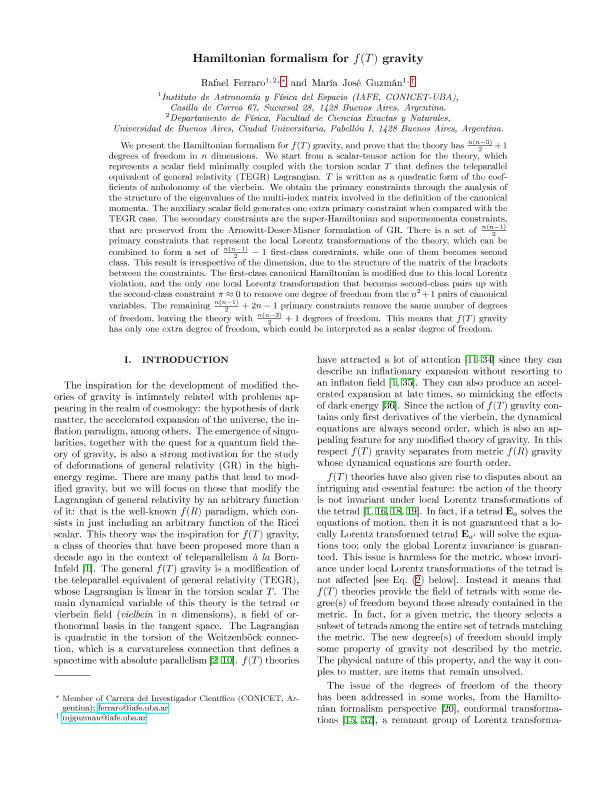Mostrar el registro sencillo del ítem
dc.contributor.author
Ferraro, Rafael

dc.contributor.author
Guzmán Monsalve, María José

dc.date.available
2019-07-30T14:37:08Z
dc.date.issued
2018-05
dc.identifier.citation
Ferraro, Rafael; Guzmán Monsalve, María José; Hamiltonian formalism for f (T) gravity; American Physical Society; Physical Review D; 97; 10; 5-2018; 1-16
dc.identifier.issn
2470-0010
dc.identifier.uri
http://hdl.handle.net/11336/80574
dc.description.abstract
We present the Hamiltonian formalism for f(T) gravity, and prove that the theory has n(n−3)/2+1 degrees of freedom (d.o.f.) in n dimensions. We start from a scalar-tensor action for the theory, which represents a scalarfield minimally coupled with the torsion scalar T that defines the teleparallel equivalent of general relativity (TEGR) Lagrangian. T is written as a quadratic form of the coefficients of anholonomy of the vierbein. We obtain the primary constraints through the analysis of the structure of the eigenvalues of the multi-index matrix involved in the definition of the canonical momenta. The auxiliary scalar field generates one extra primary constraint when compared with the TEGR case. The secondary constraints are the superHamiltonian and supermomenta constraints, that are preserved from the Arnowitt-Deser-Misner formulation of GR. There is a set of n(n−1)/2 primary constraints that represent the local Lorentz transformations of the theory, which can be combined to form a set of n(n−1)/2−1 first-class constraints, while one of them becomessecond class. This result is irrespective of the dimension, due to the structure of the matrix of the brackets between the constraints. The first-class canonical Hamiltonian is modified due to this local Lorentz violation, and the only one local Lorentz transformation that becomes second-class pairs up with the second-class constraint π ≈ 0 to remove one d.o.f. from the n^2+1 pairs of canonical variables. The remaining n(n−1)/2+2n−1 primary constraints remove the same number of d.o.f., leaving the theory with n(n−3)/2+1 d.o.f. This means that f(T) gravity has only one extra d.o.f., which could be interpreted as a scalar d.o.f.
dc.format
application/pdf
dc.language.iso
eng
dc.publisher
American Physical Society
dc.rights
info:eu-repo/semantics/openAccess
dc.rights.uri
https://creativecommons.org/licenses/by-nc-sa/2.5/ar/
dc.subject
Modified Gravity
dc.subject
Teleparallelism
dc.subject
Degrees of Freedom
dc.subject.classification
Astronomía

dc.subject.classification
Ciencias Físicas

dc.subject.classification
CIENCIAS NATURALES Y EXACTAS

dc.title
Hamiltonian formalism for f (T) gravity
dc.type
info:eu-repo/semantics/article
dc.type
info:ar-repo/semantics/artículo
dc.type
info:eu-repo/semantics/publishedVersion
dc.date.updated
2019-07-29T14:53:47Z
dc.journal.volume
97
dc.journal.number
10
dc.journal.pagination
1-16
dc.journal.pais
Estados Unidos

dc.journal.ciudad
Washington
dc.description.fil
Fil: Ferraro, Rafael. Consejo Nacional de Investigaciónes Científicas y Técnicas. Oficina de Coordinación Administrativa Ciudad Universitaria. Instituto de Astronomía y Física del Espacio. - Universidad de Buenos Aires. Facultad de Ciencias Exactas y Naturales. Instituto de Astronomía y Física del Espacio; Argentina
dc.description.fil
Fil: Guzmán Monsalve, María José. Consejo Nacional de Investigaciónes Científicas y Técnicas. Oficina de Coordinación Administrativa Ciudad Universitaria. Instituto de Astronomía y Física del Espacio. - Universidad de Buenos Aires. Facultad de Ciencias Exactas y Naturales. Instituto de Astronomía y Física del Espacio; Argentina
dc.journal.title
Physical Review D
dc.relation.alternativeid
info:eu-repo/semantics/altIdentifier/url/https://link.aps.org/doi/10.1103/PhysRevD.97.104028
Archivos asociados
